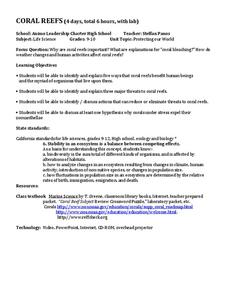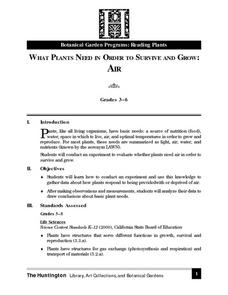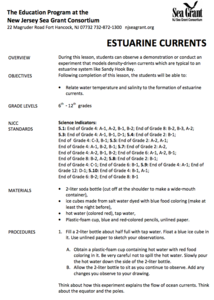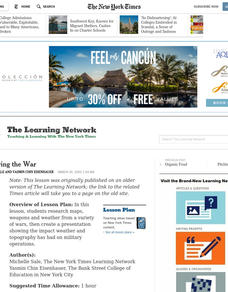Curated OER
Coral Reefs
Young scholars research coral reefs and identify their benefits to humans, threats to the reef, how to reduce and eliminate threats, and more. In this coral reef lesson plan, students research the reefs, and take a field trip to an...
Curated OER
I, Robot, Can Do That!
Young scholars describe the three types of underwater robots and the advantages and disadvantages of using them. In this underwater lesson students are given a task and identify the best robot for the job.
Curated OER
What Plants Need in Order to Survive and Grow: Air
Students conduct an experiment to determine whether plants need air in order to survive and grow. They discuss natural resources, analyze slides, and observe and record data from the experiment.
Curated OER
Abiotic and Biotic Factors
Learners examine abiotic and biotic factors. They define biotic and abiotic, categorize a list of items onto a Venn diagram, label various items from areas on the school grounds as biotic or abiotic, and diagram a magazine picture.
Curated OER
Fishing For The Future
Students participate in a simulation using M&M's that highlights Garrett Hardin's concept of the "tragedy of the commons." They use the activities to study sustainability issues in the fishing industry.
Curated OER
Net Results
Students investigate through role play how decisions by watermen, recreational fisherpeople, and lawmakers influence and are influenced by economics and the abundance or scarcity of fish and shellfish stocks. They consider social,...
Curated OER
To Culture or Not to Culture
Young scholars study the pros and cons of the aquaculture industry after reading hypothetical case study. They simulate a town meeting debate about aquaculture.
Curated OER
Busy Otters
Students prepare for a trip to an aquarium by identifying otters, their body parts and behaviors as they read "Pup's Supper", do an otter pantomime and make a puppet. After their field trip, they complete a Venn Diagram of Otter behaviors.
Curated OER
Surface Tension Grabbers
Students use the following quick activities to comprehend what surface tension is: 1. Fill a gas bottle with water. Place an uncentered burner screen over the bottle. Hold the screen in place with your finger and invert the bottle on...
Curated OER
Japanese Scientists Photograph Giant Squid
Students read and discuss a news article about scientists capturing first-ever photos of a giant squid in its habitat. They answer comprehension questions, write a journal entry from the scientists point of view, and analyze a giant...
Curated OER
Estuarine Currents
Students experiment observing a demonstration on models of density-driven currents which are typically found in an estuarine system of water flow. They compare/contrast water temperature and salinity to the formations of estuarine currents.
Curated OER
Design a Deep- Sea Vertebrate or Invertebrate
Students design a deep-sea animal. For this research based lesson, students research and design a vertebrate or invertebrate that lives in a methane hydrate habitat. They compile a class chart of the adaptations animals have in this...
Curated OER
I, Robot, Can Do That!
Students describe underwater robots. In this robot lesson, students describe and contrast three types of underwater robots used for scientific exploration. This lesson includes several activities, a handout, background data, and multiple...
Curated OER
Boom and Bust
Students investigate commercial fishery. In this fishery lesson, students describe stages in commercial fishery, interpret data and predict when a fisher stock is showing signs of overexploitation.
Curated OER
Stream Table
Students explore channelization, riparian habitats and soil erosion to find out about the aquatic habitats in Iowa. In this aquatic habitats lesson, students define important terms and read an article about pollution. Students complete...
Curated OER
Weathering the War
Students research maps, weapons and weather from a variety of wars, then create a presentation showing the impact weather and topography has had on military operations.
Curated OER
Underwater Hide and Seek
Students explain why color patterns that are easy to see above water may be difficult to detect under water and experience the problems predators face when searching for camouflaged prey.
Curated OER
Cathedral in the Sea
Learners construct a model giant kelp and kelp forest inhabitants based on field-guide photographs. Students also place animal cutouts in appropriate positions on or near the plant.
Curated OER
Coral Reef Conservation
Students conduct discussions on current threats to coral reefs around the world and write letters to conservation organizations urging support for coral reef protection.
Curated OER
Sailors and Sharks
Learners use the skills of fleeing and dodging in order to avoid being tagged. They begin standing on the ships (mats). One student, the shark, wears a pinney. At the signal from the teacher of "Sailors swim", the sailors scatter to a...
Curated OER
A Whale of a Problem
Students evaluate the possible causes contributing to the decline of the killer whale population from a number of differing perspectives. They present their findings in a talk show format and in letters of advocacy regarding
Curated OER
Properties of the Ocean: Change
Learners research and create a visual presentation on the seasonal salinity of the Earth's oceans. They apply the research in a simulation of a lab disaster in which they must relabel ocean samples.
Curated OER
A Sea-nic Perspective
Students brainstorm topics related to the health of our world's oceans. They create presentations about specific issues affecting oceans for display in a classroom exhibit. They write letters of invitation to guests to view the exhibit.
Curated OER
Blame It On El Nino
Learners understand what the weather phenomenon El Nino is and what causes it. Students recognize how remote sensing technology can detect and predict El Nino. Learners discover how El Nino effects weather conditions throughout the globe...

























